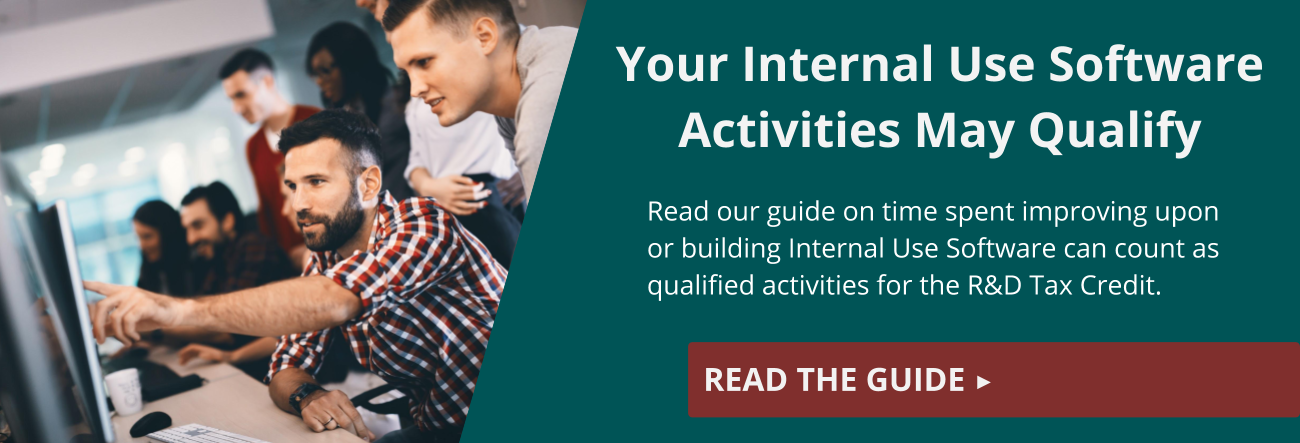 Before the US Department of the Treasury released new regulations in October 2016 providing more clarity on the definition of Internal Use Software (IUS), Dual Function Software generally wasn’t considered eligible for the R&D Tax Credit. But thanks to these new regulations, more companies are eligible to earn more tax credits based on research and development of software that helps their organizations not only internally—but their customers as well.
Before the US Department of the Treasury released new regulations in October 2016 providing more clarity on the definition of Internal Use Software (IUS), Dual Function Software generally wasn’t considered eligible for the R&D Tax Credit. But thanks to these new regulations, more companies are eligible to earn more tax credits based on research and development of software that helps their organizations not only internally—but their customers as well.
IUS is now defined as software that is developed by the taxpayer (your business) for general and administrative purposes such as financial management, human resources, and support services. The software must support the taxpayer’s business in one of these ways.
Black Line Group Chief Revenue Officer Peter Harrington has seen several instances of Dual Use Software qualifying for the R&D Tax Credit since the rule clarification, and notes that it’s relatively easy to identify this form of IUS based on its functionality. A good example is banking software (Harrington cited Bank of America’s online platform, but most large banks have similar proprietary software). These platforms were developed specifically to make it easier for customers to do business with their banks—moving money from one account to another, checking balances, depositing checks, etc. So while the software is not strictly internally facing, it’s also not developed to sell or market to third parties.
The same can be said for companies that develop and implement software to help customers place an order, check the status of their order, pay a vendor, or handle additional transactions between business and consumer. For example, think about software development needed for any business processing orders online for sales or services. This can range from major online retailers to small family-owned businesses. However, simply developing the software isn’t enough to qualify for the credit. Activities must pass both the Four-Part Test and the 3-Part High Threshold of Innovation Test.
The Four-Part Test
Once you’ve identified potential qualifying activities, run it through the four-part test to verify. The four parts of the test are:
- Permitted Purpose. This is the activity intended to make or improve either a product or process that results in improved function, performance, reliability, quality or cost-efficiency.
- Technical Uncertainty. This is the activity intended to eliminate technical uncertainty when developing or improving a product or process related to methodology, design, techniques, formulas or inventions.
- Process of Experimentation. This is the activity that includes a process of experimentation to eliminate or resolve technical uncertainty. During the process, various alternatives and approaches are evaluated by modeling, simulation, trial and error, prototyping and other methods.
- Technological in Nature. The process of experimentation must rely on hard sciences (engineering, physics, biology, chemistry, computer science).
The 3-Part High Threshold of Innovation Test
Once an activity has passed the 4-Part Test, the 3-Part High Threshold of Innovation Test will determine whether it will ultimately qualify for the R&D Tax Credit:
- The software results in cost reduction, improved speed or other measurable improvement that is substantial and economically significant.
- The software development process involves significant economic risk. This means that the taxpayer commits substantial resources to the development and there is uncertainty due to technical risk that the resources would not be recovered within a reasonable period of time.
- The software is not available to be purchased, leased, or licensed in the commercial market and is used for the intended purpose without modifications required to satisfy the innovation and significant economic risk requirements above.
These regulations are designed to encourage companies in all industries to continue to invest in “software innovation” that allows them to compete more effectively on a global basis. Companies should review their software development initiatives to understand what might qualify for a tax credit, even if things didn’t qualify in the past.
Not sure where to start? Still have questions? We are here to help.





